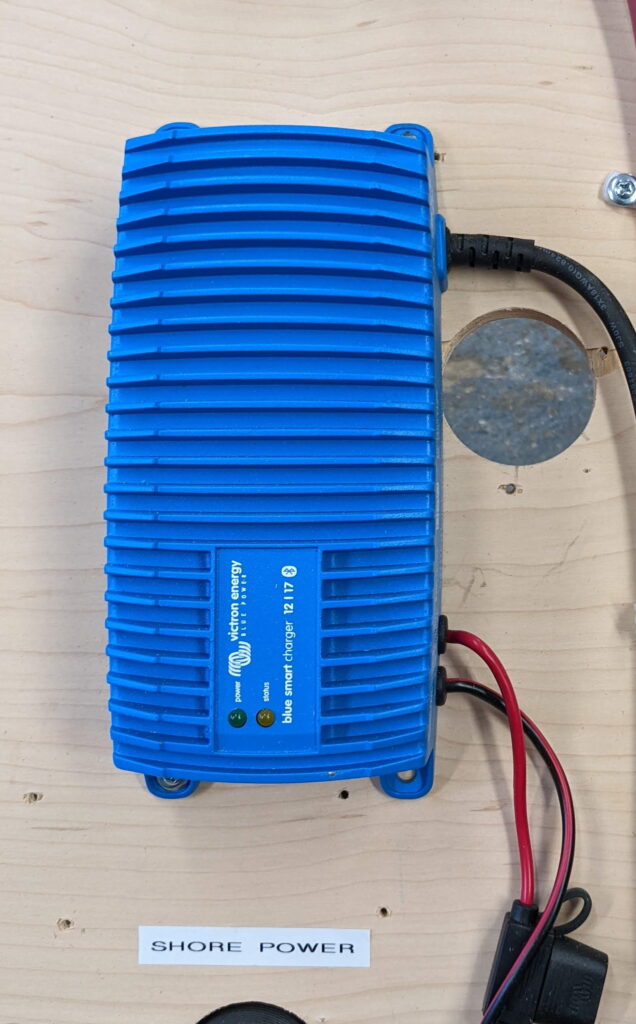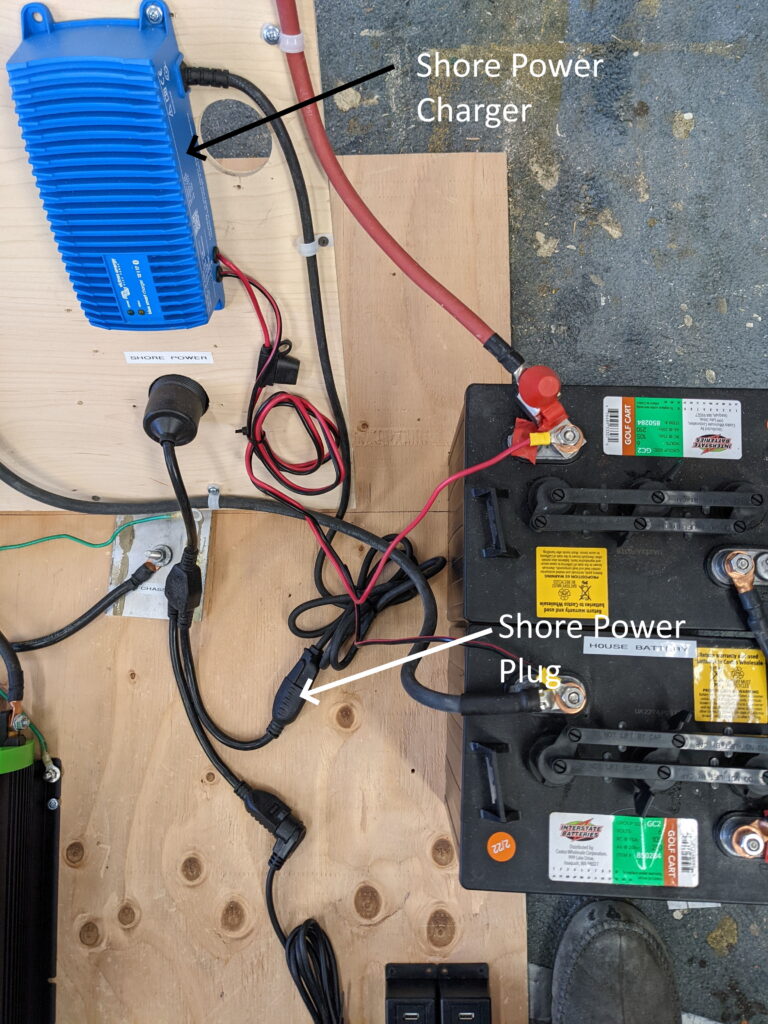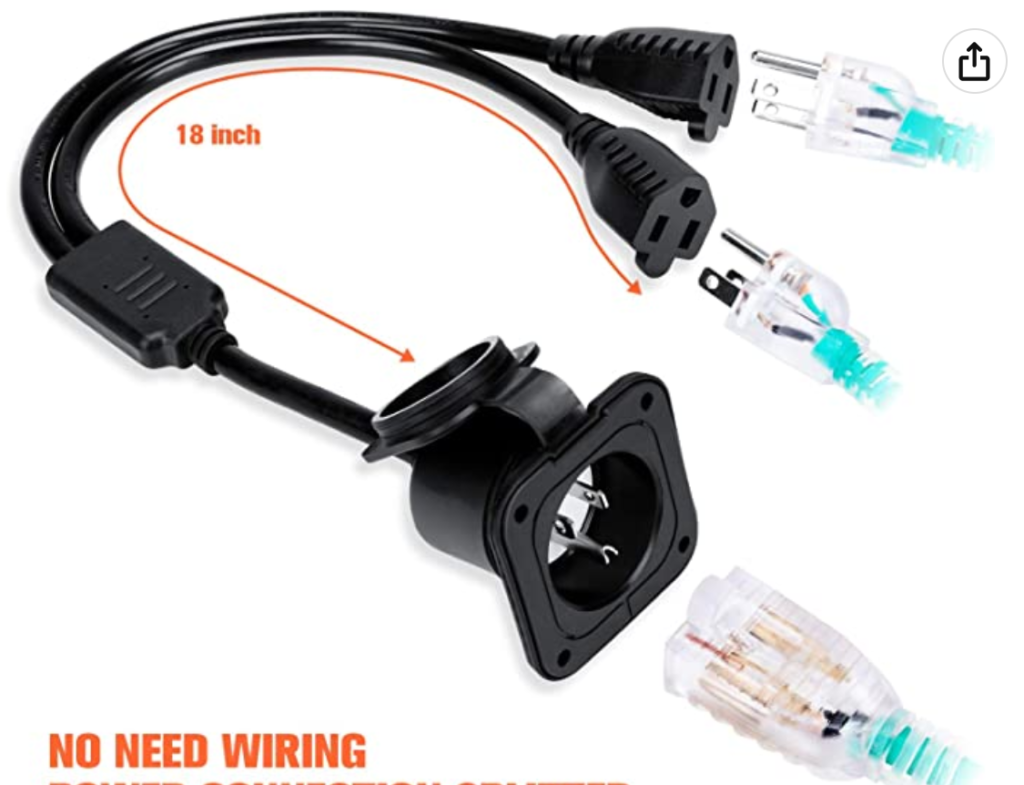Introduction – Shore Power Charger
When you have shore power available it can be handy to be able to charge the house battery from the shore power. This section adds a modest size shore power charger that will easily charge the base system batteries overnight. It can be used at campgrounds with shore power or at home.

This unit I used is a Victron Blue Smart IP67 17 amp charger. It has a solid, potted, cast aluminum case with no cooling fan and provides up to 17 amps charging for Lithium or lead batteries. It uses the Victron phone app for control and reports charging status on the phone (and on lights on the charger). It uses a full 5 stage charging profile with separate profiles for LiFePo4 and lead acid.
It can be added to the basic system with no fuss.
Components
The only component to buy is the Victron Smart IP67 charger. There are many alternative choices available both smaller and larger. I believe that they all hook up pretty much the same way. I have used this Victron for a few months and it appears to be a good quality product – if a bit pricey. I find it nice that it does not have a fan to make noise.

The red and black wires from the charger hook up to the positive and negative house battery terminals respectively. The red wire has an inline fuse for over current protection.
The 120 VAC plug on the charger plugs into your shore power connection inside your van to provide power. It is handy to use this type of shore power feed thru for your van that has two plugs on the inside – one can be used for the shore power supply and the other to plug a plugstrip into to provide house power for the van.

The charger can be turned off by just unplugging it, but you might want to consider adding an inline switch to turn it off/on.
Leaving the power supply on while the van is parked in the driveway between trips is something to think about and probably depends on which kind of batteries you have. Lead acid batteries will last long (maybe considerably longer) if kept at 100% SOC (State of Charge), so leaving them on a good charger that will not overcharge is good for them. Lithium batteries do better if kept at a medium state of charge (70%ish) between trips. This is especially true in hot weather as the combination of hot weather and high SOC will degrade LiFePo4 batteries even with no use (no cycles).
If you see any errors or misleading information on this page, or if additional information should be provided, please let me know in the comments.
Gary 7/16/22

Gary,
Regarding connection of a Victron IP67 charger to a ‘basic system’ … would it be as safe or allowable to connect it to the safety hub in similar fashion as the Kisae 1250 would be? Or, must it be connected directly to battery as you’ve illustrated?
I am nearing the end of wiring lights , fans, refrigerator, etc and remain stuck attempting final placement of battery / inverter / dc charge. I am fixated on trying to install them behind driver seat, but the dimensions of 2 SOK 12v206Ah and a Samlex 2000w inverter are quite robust. I had hoped to get the inverter under driver seat, but it just won’t happen. Perhaps the compressed installation of the Nomers power station was too hopeful for my ability and selected components.
Any thoughts?
And, as I navigate this challenge I just found some water under the floor behind driver seat (where all the electricity is hoped to be). I have no stored water in van. Perhaps a lifting of floor is in order first. I had to have new vehicle ‘warranty’ work performed a year ago due to a breached floor seam.
Gary, I remain indebted and greatly appreciative of all your work and information provided to us who want to go it on our own.
Jim
Gary-
Outstanding site and resources for making everyone’s dreams come true. I am building now based on your lessons. I purchased this shore power device and I am wondering where you cut the hole in your van. I am hoping to do so on the plastic area below the tail lights. Any guidance? There is an electric pass thru for trailer light wiring in each lower corner, did you use that?
Hi Pete,
Thanks!
My shore power just goes through the side of the van – like you see on a lot of RVs.
This dates back to my original electrical system in 2014.
Some time after that some people on the ProMaster forum worked out ways to go back through the taillight area, and I think that is the better way to do it.
This post has talks about:
https://www.promasterforum.com/threads/shore-power-receptacle-install.54026/#replies
I’m sure I’ve seen others on the forum – try a search on the forum, or post a question.
https://www.promasterforum.com
Gary